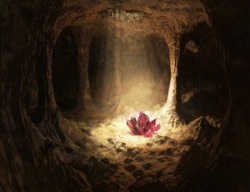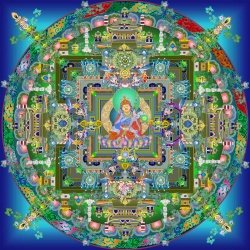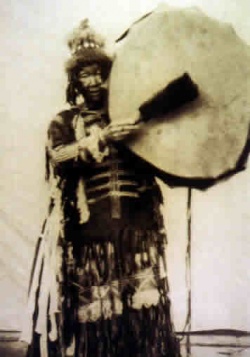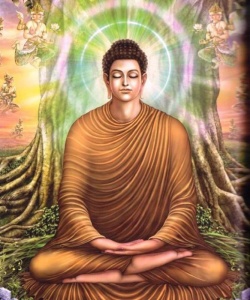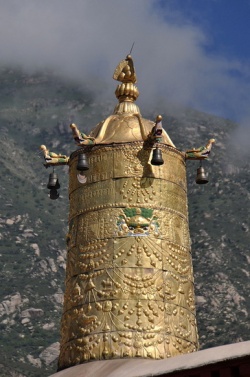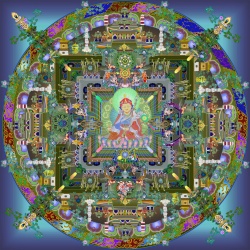Shin Arahan’s Legendary Sangha Purification
Avery Morrow
Aśoka’s policy of dhammavijaya, conquest by the dhamma rather than the sword, set a precedent for Buddhist conceptions of a good king. The image of an ideal king came to include the typical elements of conquest of enemies and peace in the kingdom, but also propagation of Buddhist dhamma, or purification of a preexisting sangha. In the space of less than 100 years, historical sources record a purification of the sangha in both Burma and Sri Lanka involving the cooperation of a spiritually pure monk and a righteous king. I find that these stories serve a satisfying purpose: they demonstrate that the Theravāda tradition is based on a true dhamma traceable directly back to the Buddha and not a later innovation, and when this dhamma becomes corrupt outside sources will come to purify it.
Burmese tradition holds that the first purification of the sangha occurred in 1056, under the reign of King Anawrahta (Pali Aniruddha). The sangha in Pagan was at that time led by corrupt “Ari” monks. The origin of “Ari” is unclear but it may simply refer to āraññaka, the forest-dwelling monastic lineage (Strong 1992, 70). According to the tradition, Anawrahta conducted the purification with the assistance of Shin Arahan, or Dhammadassi, who is said to have come from outside Pagan in the earliest sources, or specifically Thaton by the late eighteenth century (Aung-Thwin 2005, 142).
Shin Arahan by all accounts came from outside of the Ari tradition, ensuring a separation from their false dhamma. But more importantly, the Buddhism in Thaton was thought at the time to have been established by a missionary from Aśoka’s Third Council, which itself purified the sangha. According to this version of the story, when Thaton refused to send Anawrahta the Tipiṭaka, he took it by force, symbolically bringing the Triple Gem to Pagan: Buddha images, dhamma texts, and actual monks from the sangha (Strong 1992, 178).
In an alternative telling, the source of the Tipiṭaka was in Sri Lanka, which certainly did receive a mission from the Third Council, and when they refused to send it to him Anawrahta sailed over and made a copy himself (Aung-Thwin 2005, 126). In still another version relayed by Htin Aung, Shin Arahan came from Thaton not because their Buddhism was pure, but because it was defiled by Hindu images (as archaeological data suggests) and he wanted to establish a pure lineage in Pagan to oppose it (Htin Aung 1967, 32).
The first extant account of Shin Arahan’s purification of the Burmese sangha and the invasion of Thaton appears in an original history text, the Royal Chronicle (Maha Yazawin-gyi) by U Kala, written around 1712 (Aung-Thwin 2005). U Kala does not cite his sources. Michael Aung-Thwin in The Mists of Rāmañña argues that as there are no previous mentions of Shin Arahan in Burmese history, linking this purification to Thaton, rather than from within Pagan, is propaganda invented by a Mon king and spread by a collaboration of British colonialists who were attempting to draw analogies to Western history (ibid, 291). Indeed, it is doubtful that Buddhism in Thaton was much more rigid than that in Pagan (Than Tun 1988, 24). However, the story as a genuine artifact of Burmese tradition holds weight. It is a stretch to say that the British had anything to gain by glorifying the Mon, who barely existed as an independent society in the colonial period (Lieberman 2007). The motive U Kala, an ethnic Tibeto-Burman, might have for transcribing Mon propaganda he did not believe is similarly obscure, as Aung-Thwin himself admits (Aung-Thwin 2005, 138). The chronicles predating U Kala’s[1] which do not mention the story are not meant to be complete histories anyway (Charmey 2008). It is impossible to say with complete certainty whether the story in the Royal Chronicle actually happened, but the reality is that the first extant mention of the Thaton connection is from an ethnic Burmese and it was repeated in the royally commissioned Glass Palace Chronicle ( Hmannan Yazawin) without qualms. We must therefore judge this story, regardless of its origins, as having the ring of truth to it for ethnic Burmese. If the Ari monks at the time were as corrupt as is claimed, then it is intuitive to think that the Theravādin form of Buddhism which eventually prevailed in Burma must have come in from the outside and not from internal reforms.
In the Glass Palace Chronicle, a typical form of this story is conveyed (see Maung Tin and Luce 1923, 70-75) which indeed provides the basis for English histories of Burma for the next several decades. We learn that Buddhism in Pagan has reached a low point as the reign of Anawrahta begins. Thirty Ari lords and sixty thousand disciples are rejecting the Buddha’s dhamma and making up their own theories about karma, excusing even patricide and matricide as long as a special mantra is recited. Burmese of all classes are compelled by law to send their daughters to be deflowered by corrupt Ari monks before marriage. King Anawrahta sees all this and recognizes that the dhamma being taught by these monks is a false dhamma which must be corrected, but by himself, he is powerless to solve this problem.
As in the Royal Chronicle, the chroniclers of the Glass Palace Chronicle tell us that Shin Arahan is a reincarnated nat (a powerful spirit), born of a Brahmin’s virgin wife. After becoming a monk he quickly reaches the status of arahant and, seeing that true Buddhism is not being practiced properly “in the Western Country,” he heads there. A hunter discovers him in the forest and brings him to the king, who recognizes his eminence and asks him his race, place of birth, and dhamma. Significantly, Shin Arahan does not say that he is Mon. Instead, he replies that he is of the race of Buddha and that he follows Buddha’s dhamma. He then preaches a sermon, which the chroniclers (who are evidently not aiming for subtlety) assert to be the same sermon preached by the arahant Nigrodha to King Aśoka. Anawrahta, sounding as if he had never heard the true story of Buddha before, asks, “Where is my master, the Lord—the Lord Buddha? How much is the sum of the Law preached by the Lord? Liveth there any disciple and son of the Lord save thee, my master?” Shin Arahan replies describing the history of the Buddha and his relics, the extent of the Pali Canon, and the two orders of monks. Anawrahta immediately adopts Theravāda Buddhism as the practice of his kingdom. The Ari lords and monks are defrocked and made to sweep elephant dung, monks from Thaton come to Pagan to practice Theravāda, and the correct dhamma is thus brought to the Burmese people.
The English chronicler G.E. Harvey (1925) removes the mystical elements from this story, but he adds his own flourishes. Shin Arahan’s power is put into contrast with the “leering vacuity of the corpulent Aris.” The medieval quotes are rendered in Shakespearean English: “Master, of what race art thou? Whence comest thou? Whose doctrine dost thou follow?” It is superfluous to note that Shin Arahan has a romantic image in the eyes of the Burmese who conveyed the story about his miraculous birth. It is interesting, though, that the English translators who compiled a generally academic history of Burma had a similarly romantic image. For Harvey, Anawrahta fulfilled the conditions of the “good king” which he was searching for in ancient Burmese texts (Phillips 2005). Thus, he accepts the story wholesale, demonizing the Aris and characterizing the arrival of Theravāda as freedom from tyranny. The image of purification had strong connotations for Harvey as well.
Unfortunately for Harvey as well as the post-medieval chroniclers, the story of Anawrahta’s reform, in which the Ari are quickly expelled completely and an entirely different tradition coming out of Thaton is standardized across the kingdom, does not appear to reflect the reality of historical monastic and lay practice in Burma. Temples with non-Buddhist themes appear at Pagan throughout Anawrahta’s reign and continue, albeit with decreasing prominence, for perhaps several centuries later (Aung-Thwin 2005, 250). G.H. Luce (1969, 1.16) also doubts Anawrahta is as Theravādin as is traditionally claimed. The countryside of Burma is littered with tablets dedicated by Anawrahta to the bodhisattva Avalokiteśvara, who is called Lokanātha on their inscriptions (in Pali; Burmese Lokanat). This bodhisattva is still worshiped in Burma today, but it is certainly not a Theravādin practice (see Luce 1969, 1.191 and 2.4; Chutiwongs 2002).
The character of Shin Arahan’s reform, too, is not consistently remembered throughout Burmese tradition. As one account has it, he advocated for a stronger link between Burmese Buddhism and the Hindu god Vishnu (Htin Aung 1967, 41). Harvey noted that Ari frescoes, reflecting Nepalese and northern Bengali style, appear on a temple which was said to have relics brought there by Shin Arahan himself (Harvey 1925, 26-7). Even the Glass Palace Chronicle contains an overlooked story, chronologically out of place, where the Ari trick Anawrahta into believing the truth of their doctrine after the arrival of Shin Arahan by hiding manuscripts in a tree and having an oracle come and announce their miraculous appearance (Tin and Luce 1923, 39). This story is inserted with sufficient distance before the story of Shin Arahan, so that when the chroniclers describe the life of Anawrahta, it appears that the Ari were dispelled at once as soon as the righteous king and the righteous monk joined forces. While the statue of him at Pagan (Luce 1969, plate 276) attests that Shin Arahan was certainly an historical person and not just Mon propaganda, evidence for the reform attested to him cannot be found at Pagan, and the full range of stories in Burmese cultural memory demonstrates that his reform was not so neat and tidy as the post-medieval narrative suggests. As Than Tun (1988, 23) writes, “Buddhism during the Buddha’s lifetime was in a sense pure, but as time went by it was modified to suit the time and place. Burma is no exception.”
What value, then, does this story have to the Burmese? To answer this, we should consult contemporary stories of sangha purification from other parts of the Buddhist world. In the 11th century in Tibet, Atīśa (982-1054) was working to restore knowledge of the sutras and eradicate abuse of tantra in Tibetan Buddhism. In Sri Lanka, Parākramabāhu I (1123-1186) would soon be resolving inter-sangha arguments. It is this second case, because it also pertains to Theravāda monastic disciple, which I will compare to the legendary reform of Shin Arahan.
Parākramabāhu, who acquired the surname the Great in Sinhalese histories, carried out many domestic reforms and unified the kingdoms of Sri Lanka. The religious part of the reform began when Parākramabāhu noticed by himself, as Anawrahta did in Burma, that the sangha was in need of purification (see Geiger 1929, 101-4). The problems of the Sri Lankan sangha were quite different than the ones in Pagan. The monks there aspired to practice Theravāda, but there were three separate nikāyas, they refused to hold the pāṭimokkha recitation ceremony together, and were concerned primarily with the villages which the sangha had come to own through many centuries of land donations. Like Anawrahta, Parākramabāhu did not work alone. The task of unification was given to an elder monk named Mahākassapa, which the monk compiling the Cūḷavaṃsa compares to Aśoka’s appointment of Moggaliputtatissa to hold the Third Council. In Aśoka’s time, too, righteous monks were refusing to meet with corrupt monks, causing incomplete meetings of the sangha. This dispute was resolved by expelling the corrupt monks (Ronkin 2005, 24). Parākramabāhu solves the problem in a more peaceful way: he allows some heretical monks to reenter the sangha as novices, gives others jobs in government, and brings all the other monks together and has them go through each issue of dispute and resolve them in turn, with Mahākassapa acting as the elder with the most authority. “After he had thus by cleaning the order, cleansed the inward impurity of the bhikkus, in order to cleanse the outward impurity, that one might be able to bathe in great heat he had eight bath-houses of stone erected.” Parākramabāhu builds many stūpas, relic shrines, and and dwellings for the monks, creating great merit for himself.
In this passage, a different dispute is handled in a different way, in a quite different kingdom, but the basic elements of the reform remain the same. The political power needed to reform the sangha can come only from a king who recognizes the problem. The king, however, cannot assert control over the sangha without the assistance of a monk well-versed in the dhamma, and in both countries, these monks are portrayed in a positive light because of their role in the purification, rather than being seen as power-hungry. Parallels to Aśoka’s dhammavijana are drawn, and the sangha is not only reformed but given the renewed assistance of the kingdom. Parākramabāhu gives that assistance in the form of new buildings; Anawrahta retrieves the tooth and hair of the Buddha from Sri Lanka, and on the advice of Shin Arahan displays it publicly so that “all beings may worship [it] during the full five thousand years of the religion.” (Tin and Luce 1923, 91)
Reform of the sangha later became an institution in Burma and was performed on a frequent basis. Reforms would reduce the size and estate of the sangha, providing a counterbalance to the land and money that was constantly being donated. Burmese historians frequently connected wealthy sanghas with corruption. As the Glass Palace Chronicle demonstrates with its example, these reforms always required the political power of a king to initiate, and the religious power of one or more monks to legitimize. The king would send the monks to Sri Lanka to be re-ordained; a portion of the rest of the sangha would then be ordained underneath them. After a “safe” number of monks were re-ordained the king would stop the process. In order to create a complete reform the entire sangha would have to be reorganized under this new order of seniority, its servants and contractors fired, and the barriers of all its monasteries redrawn. If this was carried out successfully, the sangha would be considered pure, and the king strong; if the king failed to complete the purification, he would be seen as weak and the sangha as corrupt, and as the wealth of the sangha grew his treasury would shrink (Aung-Thwin 1979). Because unregulated growth of the sangha posed a threat to the king, if Anawrahta did aim to install an entirely new sangha and expel the Aris, he may have had these economic and political motivations in mind.
Aung-Thwin (1979) writes that “purification in a Buddhist context means returning to the orthodoxy of the past.” The Shin Arahan reform story fulfills that desire twice over. Not only does it include the rediscovery of the Tipiṭaka from the time of the Buddha, it hearkens to the time of Aśoka who was universally well-remembered as the ideal state sponsor of Buddhism. Additionally, it serves as an historical precedent for future necessary reforms. The purification of the sangha is a sensible idea to Buddhists (Aung-Thwin 2005, 151): since the fundamental truth of impermanence guarantees that the sangha will decay over time, leadership and other outside influence which keeps it running until the time of Maitreya is welcomed.
References
Michael A. Aung-Thwin. “The Role of Sasana Reform in Burmese History: Economic Dimensions of a Religious Purification.” The Journal of Asian Studies 38.4 (1979), pp. 671-688.
——. The Mists of Rāmañña. Honolulu: University of Hawaiʻi Press, 2005.
Michael W. Charney. Review of The Mists of Rāmañña by Michael Aung-Thwin. H-ASIA. 6 February 2006. H-Net. 7 June 2008. http://snurl.com/ramanna
Nandana Chutiwongs , The Iconography of Avalokitesvara in Mainland South East Asia New Delhi: Indira Gandhi National Centre for the Arts and Aryan Books, 2002.
Wilhelm Geiger (trans.) Cūḷavaṃsa. Pali Text Society. 1929. New York: Routledge & Kegan Paul, 1973.
Victor Lieberman. Review of The Mists of Rāmañña by Michael Aung-Thwin. Journal of Southeast Asian Studies 38.3 (2007) , p. 383.
G.H. Luce. Old Burma—Early Pagán. Locust Valley, NY: Artibus Asiae, 1969. vol. 1 p. 16.
G.E. Harvey. History of Burma. 1925. New York: Octagon Books, 1967.
Htin Aung, A History of Burma. New York: Columbia University Press, 1967.
P.E. Maung Tin and G.H. Luce (trans.) The Glass Palace Chronicle of the Kings of Burma. 1923. New York: AMS Press, 1976.
Alyssa Phillips. “Romance and Tragedy in Burmese History: A Reading of G.E. Harvey’s The History of Burma.” SOAS Bulletin of Burma Research 3.1 (2005). pp. 1-26.
Noa Ronkin. Early Buddhist Metaphysics. New York: Routledge, 2005.
John Strong. The Legend and Cult of Upagupta. Princeton: Princeton University Press, 1992.
Than Tun. Essays on the History and Buddhism of Burma. Berwick, Scotland: Kiscadale Publications, 1988.
[1] Aung-Thwin (2005, p. 123) claims Shin Arahan is mentioned in a fourteenth century text, but the quote he uses is from 1781 because it is “more complete.”

